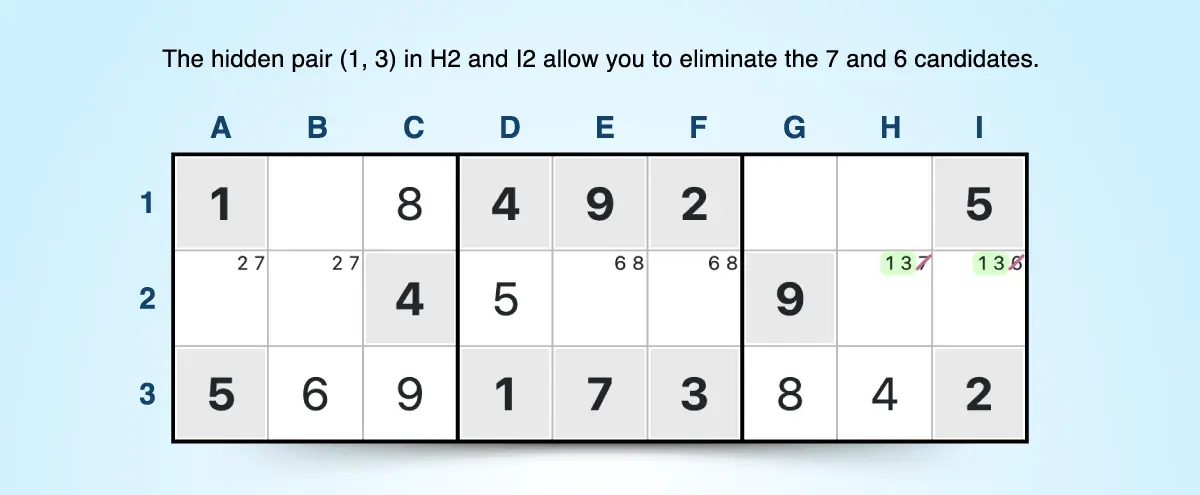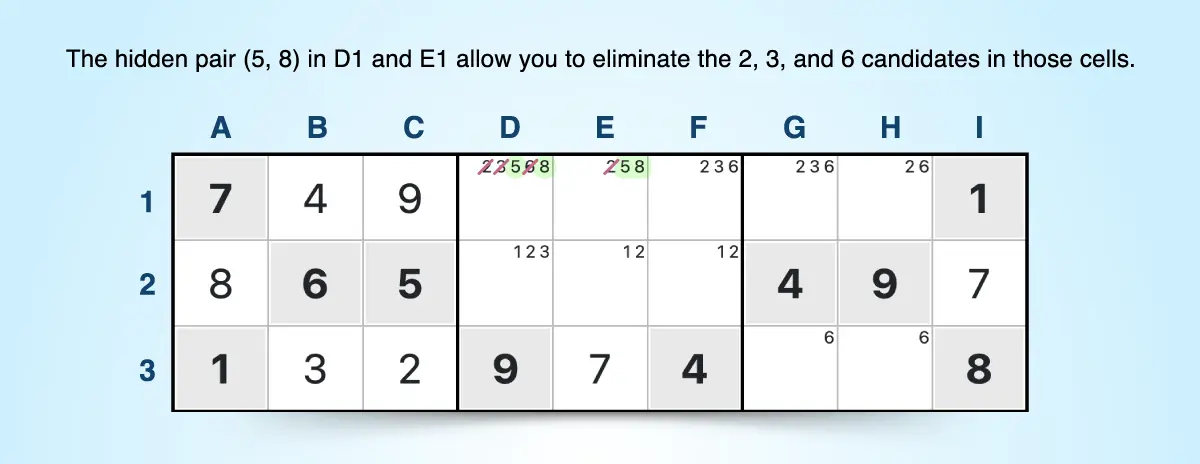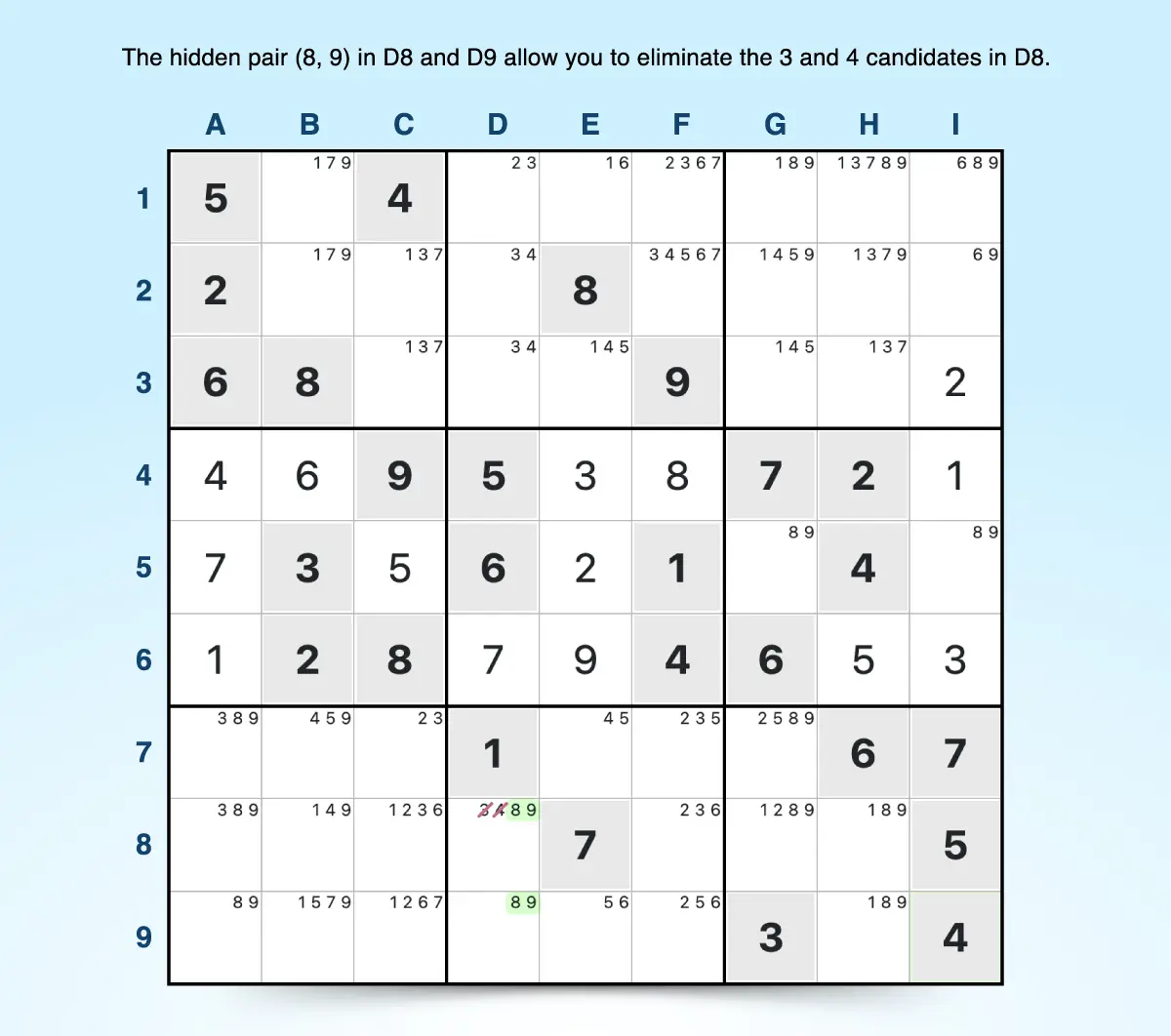Sudoku Hidden Pairs Technique and Examples
Hidden pairs occur when two cells within the same row, column, or 3x3 block share two candidate numbers that no other cells contain. The two cells with this hidden set of numbers may contain other candidate numbers, which is why they’re considered hidden. You can eliminate all other candidate numbers within these cells because logically the cells have to contain one of the two options in the hidden pair.
This Sudoku strategy is great for both beginners and advanced players learning how to play, helping you to eliminate candidates and solve your Sudoku puzzle more quickly.
How to Find Hidden Pairs
Remember, hidden pairs must meet the following criteria:
- Two cells within the same row, column, or 3x3 block share exactly two candidate numbers.
- The two candidate numbers do not appear in any other cells within that row, column, or block.
- Other candidates that are not part of the hidden pair appear in at least one of the two hidden pair cells.
To identify hidden pairs, note all possible candidate numbers within each cell, then scan rows, columns, and blocks for two cells with the same two candidate numbers. Ensure these numbers don’t appear in any other cell within that unit. For example, if one cell within a row has a 1, 3, and 5 candidates, another cell has 2, 3, and 5 candidates, and 3 and 5 are not candidates for any other cells in that row, 3 and 5 are the hidden pair.
Naked triples and naked quads often contain hidden pairs, so remember to scan the whole unit and look closely at cells that contain multiple candidates.
Hidden Pair Examples
Hidden pairs don’t just help you eliminate numbers in two cells. They often create chain reactions, allowing you to find answers and eliminate numbers elsewhere in the puzzles. As you search for hidden pairs, you may even discover a single candidate that leads to the locked candidate technique. Here are a few examples showing how they work in action.
Hidden Pairs in a Row

In this example, you can find the hidden pair (1, 3) in cells H2 and I2. Verify it is a hidden pair by seeing if 1 or 3 appears in any other cell in row 2. Because it doesn’t, you can remove the 7 candidate in H2 and the 6 candidate in I2.
In addition to the hidden pair, there are two sets of naked pairs in row 2: A2 and B2 (2, 7) and E2 and F2 (6, 8). If you noticed the naked pairs before the hidden pair, they also would have allowed you to eliminate the 7 in H2 and 6 in I2 because the naked pairs indicate that no other cells in that row can contain 2, 7, 6, or 8.
Hidden Pairs in a Block

This example shows the hidden pair (5, 8) in cells D1 and E1 of the center block. Verify this by checking that 5 and 8 don’t appear in any other cells in the middle 3x3 block. Now you can eliminate candidates 2, 3, and 6 in D1 and candidate 2 in E1.
Looking at the middle block, this leaves you with 6 as a hidden single in F1 and 3 as a hidden single in D2. By identifying the hidden pair, you were able to find the answer for two cells within the block.
Hidden Pairs in a Column

There is a hidden pair (8, 9) in cells D8 and D9 of column D. This allows you to eliminate candidates 3 and 4 in D8, giving you a naked pair (3,4) in D2 and D3 and a hidden single (2) in D1. The naked pair (3,4) helps you eliminate the other 3 and 4 candidates in the top center 3x3 block.
Looking for hidden pairs is a great way to level up your Sudoku skills and solve intermediate or hard Sudoku puzzles. Once you’re comfortable with hidden pairs, you can easily add hidden triples to your solving skillset. Read our blog for more Sudoku solving techniques and explore our archive for hundreds of free Sudoku games.